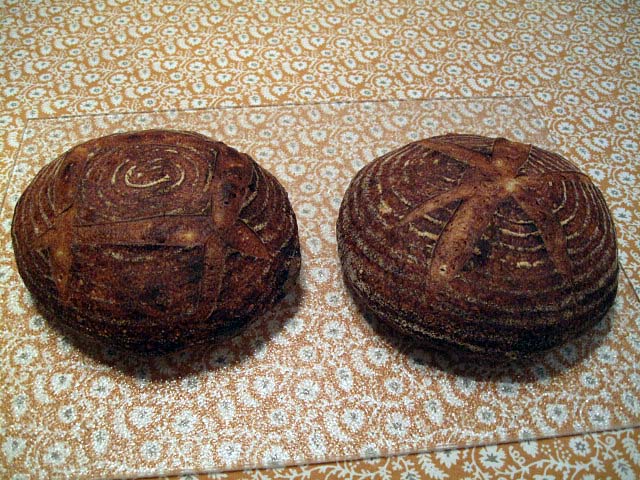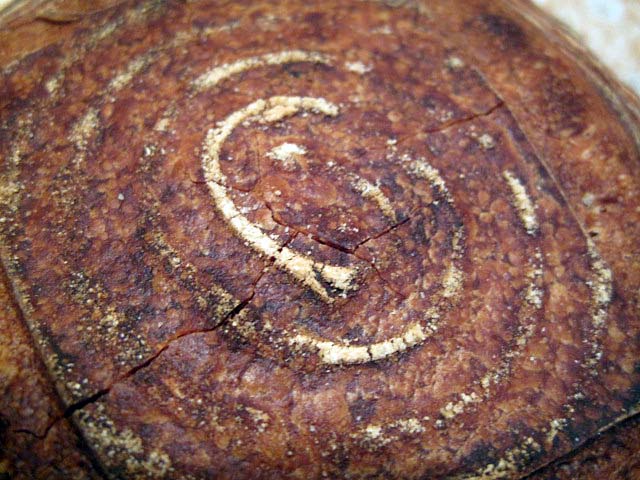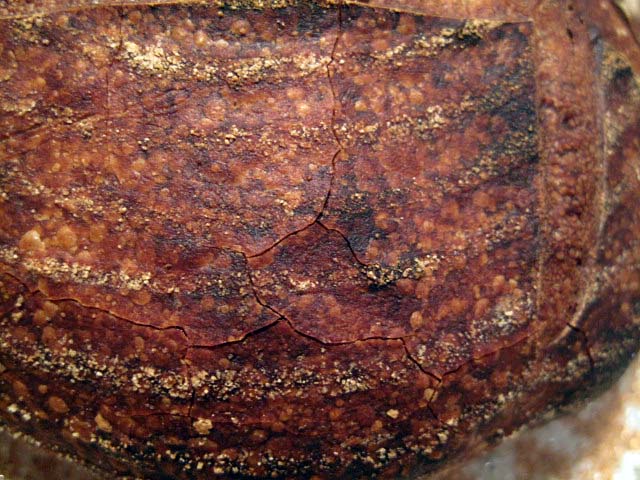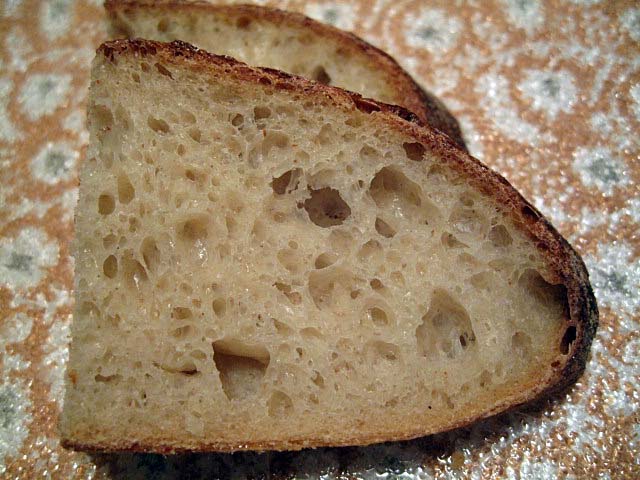Today's bake:
I was asked by a TFL member who had already packed his copy of Advanced Bread & Pastry in preparation for a move for the formula for this bread. I have added it, below. Happy baking!

Boules
Levain |
|
|
Ingredient | Amount (Lbs & Oz) | Bakers' % |
Bread flour | 2 1/2 | 95 |
Medium rye flour | 1/8 | 5 |
Water | 1 1/4 | 50 |
Starter (stiff) | 2 1/8 | 80 |
Total | 5.75 | 230 |
Mix all the ingredients with a DDT of 70ºF.
Ferment 12 hours at room temperature (65-70ºF).
Final dough |
|
|
Ingredient | Amount (Lbs & Oz) | Bakers' % |
Bread flour | 14 7/8 | 100.00 |
Water | 10 7/8 | 72.80 |
Salt | 3/8 | 2.53 |
Levain | 5 3/4 | 40.00 |
Total | 2 lb | 215.33 |
Method
Mix to medium consistency.
Ferment 3 hours with 1 fold. (I did 2 folds at 45 minute intervals.)
Divide into 1 lb pieces.
Preshape as light balls.
Rest 20-30 minutes.
Shape as boule or bâtard.
Proof 12-16 hours at 48ºF, 65% relative humidity.
Score as desired.
Bake 35 minutes at 450ºF with steam.


Crackly Crust

Crumb
David
- dmsnyder's Blog
- Log in or register to post comments
Eric
:-)
This is the 3rd bread I've made from AB&P. So far, all are winners.
David
but even more the wonderful dark color you get. The crackles are great but the rich dark color is even better. How do you get it so dark and still keep it so thin?
OldWoodenSpoon
David, the loaves look gorgeous inside and out.
What size bannetons do you use and where did you get yours from? Thanks.
weavershouse
I would love a slice. It looks so delicious! Lovely, lovely crackles : ) How did you bake to get the crackles?
Sylvia
Hi, OWS, weavershouse and Sylvia.
Thanks for your kind words.
To get a darker yet still thin crust, bake with steam at a higher temperature. The formula called for baking at 450ºF. I baked these loaves at 475ºF. I was experimenting with Shiao-Ping's notion that the crackly crust comes from baking at a higher temperature and taking the loaves out of the oven without leaving them in the turned off oven to start cooling.
Only one of the two loaves - the one with the tic-tac-toe scoring - developed any crackles.
My bannetons are those for 1-1.5 lb loaves from the SFBI.
David
This bread will inspire any new baker on this site.
My experience is that most really "new" bakers - at least those with no experience of European breads - would perceive my loaves as "burnt." They are a bit overly "bold baked," even to my taste. Not that they taste burnt at all.
David
I admit that I lack experience with baking European breads, but having spent a fair amount of time working in Europe in the 90's, I cannot recall ever seeing bread presented with that dark of a crust. England, Germany and France...none of them showed this deep, dark coloration. I primarily worked and stayed in large cities, so maybe the common people bake to this level, but I did not see it. I believe that overbaking to this degree has a dramatic shift in the taste of the bread if you eat the crust, and I can't help but believe it may have dried out the crumb to some degree.
Did you check the internal temperature of the bread to see when it was actually done baking or just bake at time & temp according to the recipe? I have found that many "Celebrity Artisan" bakers times are too long and temps are too high for my liking. I make sourdough high hydration long fermentation loaves frequently, and I use a thermometer to determine when the bread is done, especially when making a new recipe, then note that for future bakes. This is an example of what I see when baking artisan breads. This loaf was baked to 205F and was pulled from the oven.
Here is the crumb from that loaf...
I don't mean to demean your bake, but I just don't agree that baking bread to that level of doneness is the best way to bake bread.
Hi, Joe.
I do happen to like the flavor of a darker crust, and I think it has become fashionable among artisan bakers. We read that this is how it's done in Europe, and I do recall some rustic loaves baked in smaller towns in France that were darker than what was common in this country at the time.
That said, this particular bake was darker than I happen to like. I was specifically aiming to achieve a crust with crackles and following Shiao-Ping's notion of how to best achieve that. (Please - Any fault with this bread is entirely mine, not Shiao-Pings. I baked it. She didn't.)
I do monitor the internal temperature of the bread, but 205ºF is my minimum. If I want the crust darker, I may extend the bake by up to 5 minutes. I've never had an unpleasantly dry crumb.
Thanks for your interesting input. Lovely bread, by the way!
David
I do agree with that!
A B & P?
I've been making 1-2-3 bread with an overnight rise once formed and baking at high temp and taking out once they're done rather than leaving in as I once did. I've been getting a nice crackly crust, but it doesn't last a long time. If I let it stay in until it's quite caramelized, it sings. Is that your experience?
Patricia
Do you mean the cracks close up? Or that the breads are so delicious they get consumed immediately?
The bread singing is the sound the loaf makes as it shrinks when the crust is really dry and cannot shrink along with the crumb. The cracks occur when the shrinkage is sufficient to fracture that dry crust.
In principle, the color of the crust doesn't matter. How dry it is matters. The two are correlated, but consider baguettes, which can have a relatively pale crust yet be crackly.
Shiao-Ping and I have been discussing this issue in her Gerard Rubaud topic. In the last "scrimmage," I think she punted to her daughter who just entered university, perhaps as a physics major.
David
Advanced Bread & Pastry by Michel Suas.
David, those look awesome!
Betty
And thanks picking up on Patricia's question. I missed it.
David
David, how do you stretch and fold? in the bowl with a plastic bowl scraper? I admire your holey crumb, and strive to achieve it. I have managed to bake wholewheat breads that are light and fluffy using the stretch and fold technique, but i have yet to get the results you are experiencing.
Truely inspiring !
Mebake
See these links, Mebake:
Hamelman no-knead French bread
no-knead video
David
i'd be a happy cowgirl! those holes look like they belong to the solar system - magnifico...
David
I was hoping you would post it!
weavershouse
Hi David. I have a naive question regarding the characteristic waxy look the sour dough holes have. You mentioned gelatinzed starch. Non sour dough breads usually do not exhibit that degree of shine, yet they go through a similar gelatinization. What is happening that is different? Thanks. Ray
I bake so few breads that are not sourdough, I'm not sure I can answer your question about gelatinized starch. Let me think about it and do a bit of book research. Maybe I can find an answer.
David
David,
Lovely looking loaves, as usual. I believe that there may be a typo in the amount of water in the levain, however. To get all the numbers to add up, the amount of water should be ~1 1/4 ounces rather than the 6 1/2 indicated. I hope this will help save others from a "watery grave".
Jessica
Hi, Jessica.
You are right ... and wrong.
The number are correctly transcribed from the book, I'm pretty sure. And you are correct that they don't add up. However, the dough ends up within one percent of the specified hydration level. It is a wet dough, but managable, and it makes delicious bread.
These "errors" appear to be systematic enough so that I have trouble believing they are typos or poor editing. This needs more investigation. I need to check multiple formulas in the book for a pattern.
David
Hi, David.
I think I see where the discrepancy comes from. On page 201 of AB&P, there are two columns on the far right. The last column is "Test" (for a trial loaf size) which looks to have the same amounts you use in your formula except for the water which is 1 1/4 oz. The column next to it is labeled "Lb & Oz" and is for the standard size loaf and this uses the figure of 6 1/2. I think when you typed up the formula, this figure wandered on to the keyboard. Hopefully, this will clarify the matter.
Jessica
It sounds like you uncovered the source of the error. I'll check it myself when I get home tonight.
I did type up the tables in a hurry last night, in response to a special request, so "haste makes waste," eh?
I'll correct the OP, when I've confirmed your discovery.
David
Glad I could help and return the favor, after all I have gained from your sharing your expertise.
Jessica
David
delete
What and where do you buy the basket for this wonderful round bread?
http://www.sfbi.com/baking_supplies.html
David
What is Starter (stiff) for the lavain?
You can start with any active sourdough starter, but a "stiff" starter is generally one that is 50-65% hydration. (50% hydration means the starter has half as much water, by weight, as flour.)
David
Hello, I have been working on baguettes lately. I am using the formula for Stirato in "Local Breads" and cannot get the open, holey crumb that I am looking for. The biga is : 150 g flour, 3 grams instant yeast, 90 gr water. I increased water to 95 grams.
The biga is retarded in fridge after 1 hours at room temp for about 12 hours.
The dough is:
Biga, 295 gr water, 5 grams instant yeast, 400 gr flour 10 gr salt. I mixed than kneaded with Kitchen Aid at 2nd speed for 5 min. Dough was pretty sticky. I did 2 S&F and proofed for 2 hours, til doubled. I shaped carefully as baguette, about 13 inc long and proofed in baguette form for 50 min. Baked at 450, no stone, 1/4 c water in cast iron skillet that preheated 1 hr. It was beautiful and very tasty....some nice translucscene in the crumb...but not the Big loose crumb that I was hoping for. There was not King Aruther flour at our store so I used a bread flour without added gluten. I have been making sourdough for years and add gluten to my flour at 1 tsp per c....do you think this would help my crumb on the baguette...thoughts. Thanks for your time.
Sitka Baker, Alaska
There are so many factors that influence crumb structure.
You have a reasonable dough hydration. Your yeast and salt are on the high side.
If you use higher gluten flour or add gluten (which I never do), you may need a longer mix or more S&F's to fully develop it.
The dough needs a good bulk fermentation, and I can't judge yours. The dough should be pretty gassy and feel light.
You need to handle the dough gently during shaping, but also form a good gluten sheath.
Proofing needs to be just right. Use the poke test to judge this.
It's not absolutely necessary, but a baking stone that is well heated does help with oven spring.
Photos of your baguettes including crumb photos might help pinpoint your problem.
Why don't you start a new topic, and you will get lots of help, I'm sure.
David
I made some adjustments and I have photos but unfortunately I am having trouble understanding how to upload to TFL....the crumb is definitely much better. I increased mix time, handled carefully, longer bulk fermentation....I will continue to tweak. Do you have an e-mail address where I can send photos? If that's not appropriate I understand....Sitka Baker.
Uploading photos is not that difficult. There is a FAQ on the topic. Have you seen it?
I generally either take photos at the resolution I want to upload - usually 640 x 480 pixels - or use a photo editing program to scale them. I save the photos to my desktop, then use the TFL message editing functionality to upload and insert them into a message.
If you need more details, ask for help.
David
I posted photos...just getting the hang of this and wasn't able to get the text in. As we ate our way through the baguette I noticed that there were some irregular holes...again, nice transluscene but not as open as I liked. Sitka Baker
Hello, thanks for the tips...I may get this yet. Here is another pic of the crumb.
I HAVE JUST FOUND THIS RECIPE WHICH LOOKS DELICIOUS BUT I HAD MAJOR TROUBLE DECIPHERING THE AMOUNTS AS YOU LISTED THEM --- I AM A MATHEMATICIAN BUT DID NOT UNDER THE AMT. WHEN THE HEADING SAID LBS. & OZ. AND THE NUMBER BELOW WAS 2 1/2 --- DOES THIS MEAN 2 LBS AND 1/2 OZ OR WHAT -- AFTER SOME STUDYING I FINALLY FIGURED IT OUT BUT I FIND THIS NOTATION VERY CONFUSING ---- I DO NOT MEAN TO BE RUDE BUT I THINK THERE IS A BETTER AND MORE CLEAR WAY TO STATE THESE AMOUNTS -- IT FINALLY BECAME CLEAR WHEN I SAW YOU HAD PUT THE WEIGHT IN POUNDS IN BOLD TYPE --- I MAY BE THE ONLY ONE CONFUSED --- I JUST WANT THE INSTRUCTIONS TO BE CLEAR AND HAD NO INTENTION OF LOOKING FOR AN ARGUMENT --- I WILL TRY THIS RECIPE SOON AND WILL LET YOU KNOW HOW IT TURNS OUT ---
SLKIRK
Hi all,
May I ask what is the technique for getting the most "shine" in your bread crumb?